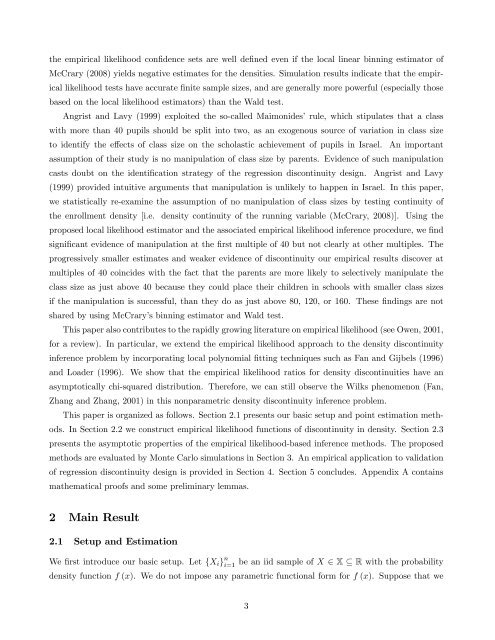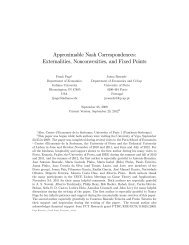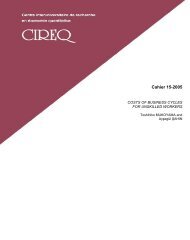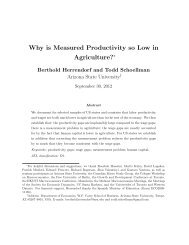Estimation and Inference of Discontinuity in Density
Estimation and Inference of Discontinuity in Density
Estimation and Inference of Discontinuity in Density
You also want an ePaper? Increase the reach of your titles
YUMPU automatically turns print PDFs into web optimized ePapers that Google loves.
the empirical likelihood con…dence sets are well de…ned even if the local l<strong>in</strong>ear b<strong>in</strong>n<strong>in</strong>g estimator <strong>of</strong>McCrary (2008) yields negative estimates for the densities. Simulation results <strong>in</strong>dicate that the empiricallikelihood tests have accurate …nite sample sizes, <strong>and</strong> are generally more powerful (especially thosebased on the local likelihood estimators) than the Wald test.Angrist <strong>and</strong> Lavy (1999) exploited the so-called Maimonides’ rule, which stipulates that a classwith more than 40 pupils should be split <strong>in</strong>to two, as an exogenous source <strong>of</strong> variation <strong>in</strong> class sizeto identify the e¤ects <strong>of</strong> class size on the scholastic achievement <strong>of</strong> pupils <strong>in</strong> Israel. An importantassumption <strong>of</strong> their study is no manipulation <strong>of</strong> class size by parents. Evidence <strong>of</strong> such manipulationcasts doubt on the identi…cation strategy <strong>of</strong> the regression discont<strong>in</strong>uity design. Angrist <strong>and</strong> Lavy(1999) provided <strong>in</strong>tuitive arguments that manipulation is unlikely to happen <strong>in</strong> Israel. In this paper,we statistically re-exam<strong>in</strong>e the assumption <strong>of</strong> no manipulation <strong>of</strong> class sizes by test<strong>in</strong>g cont<strong>in</strong>uity <strong>of</strong>the enrollment density [i.e. density cont<strong>in</strong>uity <strong>of</strong> the runn<strong>in</strong>g variable (McCrary, 2008)]. Us<strong>in</strong>g theproposed local likelihood estimator <strong>and</strong> the associated empirical likelihood <strong>in</strong>ference procedure, we …ndsigni…cant evidence <strong>of</strong> manipulation at the …rst multiple <strong>of</strong> 40 but not clearly at other multiples. Theprogressively smaller estimates <strong>and</strong> weaker evidence <strong>of</strong> discont<strong>in</strong>uity our empirical results discover atmultiples <strong>of</strong> 40 co<strong>in</strong>cides with the fact that the parents are more likely to selectively manipulate theclass size as just above 40 because they could place their children <strong>in</strong> schools with smaller class sizesif the manipulation is successful, than they do as just above 80, 120, or 160. These …nd<strong>in</strong>gs are notshared by us<strong>in</strong>g McCrary’s b<strong>in</strong>n<strong>in</strong>g estimator <strong>and</strong> Wald test.This paper also contributes to the rapidly grow<strong>in</strong>g literature on empirical likelihood (see Owen, 2001,for a review). In particular, we extend the empirical likelihood approach to the density discont<strong>in</strong>uity<strong>in</strong>ference problem by <strong>in</strong>corporat<strong>in</strong>g local polynomial …tt<strong>in</strong>g techniques such as Fan <strong>and</strong> Gijbels (1996)<strong>and</strong> Loader (1996). We show that the empirical likelihood ratios for density discont<strong>in</strong>uities have anasymptotically chi-squared distribution. Therefore, we can still observe the Wilks phenomenon (Fan,Zhang <strong>and</strong> Zhang, 2001) <strong>in</strong> this nonparametric density discont<strong>in</strong>uity <strong>in</strong>ference problem.This paper is organized as follows. Section 2.1 presents our basic setup <strong>and</strong> po<strong>in</strong>t estimation methods.In Section 2.2 we construct empirical likelihood functions <strong>of</strong> discont<strong>in</strong>uity <strong>in</strong> density. Section 2.3presents the asymptotic properties <strong>of</strong> the empirical likelihood-based <strong>in</strong>ference methods. The proposedmethods are evaluated by Monte Carlo simulations <strong>in</strong> Section 3. An empirical application to validation<strong>of</strong> regression discont<strong>in</strong>uity design is provided <strong>in</strong> Section 4. Section 5 concludes. Appendix A conta<strong>in</strong>smathematical pro<strong>of</strong>s <strong>and</strong> some prelim<strong>in</strong>ary lemmas.2 Ma<strong>in</strong> Result2.1 Setup <strong>and</strong> <strong>Estimation</strong>We …rst <strong>in</strong>troduce our basic setup. Let fX i g n i=1be an iid sample <strong>of</strong> X 2 X R with the probabilitydensity function f (x). We do not impose any parametric functional form for f (x). Suppose that we3






